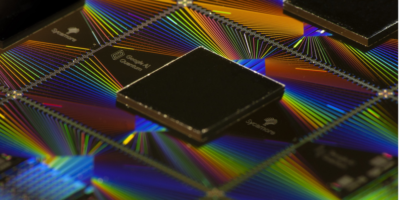The Internet of Things (IoT) is a paradigm-shifting technological trend in which everyday objects, from refrigerators to watches, are transformed into smart devices with Internet connectivity. These objects can share data with each other, making it possible to automate and enhance many aspects of daily life.
Antennas play a pivotal role in these devices. An antenna is a device that converts electromagnetic radiation into electrical current, or vice versa. This function is crucial for enabling IoT devices to communicate and exchange data with each other wirelessly, thus facilitating the interconnectedness that defines the Internet of Things.
Given the many constraints and considerations in play, however, integrating antennas into these small IoT devices (Figure 1) is a significant challenge.
Figure 1. Typical short-range wireless system. Image used courtesy of Infineon
The Challenge of Size and Space
Size limitations
In the world of IoT, small is the new big: consumers desire compact, unobtrusive devices, and manufacturers strive to comply. These size restrictions pose a significant hurdle for antenna integration.
Antennas operate based on resonating at a specific frequency, and their size is typically proportional to the wavelength of the frequency they are designed to operate on. For instance, a dipole antenna operating on a 2.4 GHz frequency band would ideally need to be approximately 6.25 cm long—a size that’s often not feasible for compact IoT devices.
Space constraints
The space within a small IoT device is crowded, presenting a complex task for antenna integration. The antenna has to function in close proximity to other components like processors, batteries, and sensors. These components can interfere with the antenna’s operation, affecting its performance and, ultimately, the device’s functionality.
For example, the metal casing of a battery, often the largest component within a compact IoT device, can disturb an antenna’s operation in two ways: it can either detune the antenna, changing its operational frequency, or due to its size it can shield the antenna, reducing the effective radiation pattern and weakening the device’s connectivity.
Similarly, processors, particularly those operating at high frequencies, generate substantial electromagnetic noise. When an antenna is in close proximity, it can pick up this noise, which interferes with its reception and transmission of signals.
Reduced Antenna Performance Due to Miniaturization
The push for smaller, more compact IoT devices is great for portability and style, but has downsides when it comes to the performance of antennas. As these devices get smaller, the antennas within them need to shrink as well. This size reduction can negatively impact many important features of how an antenna works.
Some of miniaturization’s detrimental effects on antenna performance include:
- Decreased resonance efficiency: Antennas operate on the principle of resonating with a specific wavelength and are typically sized proportionally to that wavelength. As the size of the antenna decreases, its ability to efficiently resonate with the wavelength becomes compromised, leading to reduced signal strength and decreased transmission range.
- Reduced bandwidth: Bandwidth refers to the range of frequencies an antenna can handle effectively. Smaller antennas, due to their size, typically have a more limited bandwidth. This means they can process less data at any given time, which can slow down data transmission rates and impede the overall functionality of the device.
- Increased susceptibility to detuning: In a compact device, the antenna is situated closer to other components. This close proximity can lead to detuning, a shift in the antenna’s operational frequency caused by interference from other components, particularly metallic ones.
- Impaired radiation pattern: The radiation pattern of an antenna, which describes the direction and strength of the signals it emits, can also be negatively impacted by miniaturization. A smaller antenna typically has a less ideal radiation pattern, which can result in weaker and less reliable connectivity.
Potential Solutions
There are several potential solutions to these challenges:
System on Chips (SoCs)
SoCs integrate a microcontroller unit (MCU) and an RF front end into one silicon die. By merging these two functions, SoCs make excellent use of the limited space inside an IoT device. This space-efficiency advantage is a key reason why IoT devices are increasingly designed around wireless MCUs.
Despite these benefits, SoCs can’t solve every problem: the physical size of the antenna is still limited by the wavelength of the frequency it operates on, and detuning—a shift in the antenna’s operating frequency caused by nearby components—remains a significant issue.

Figure 2. PCB antenna on the left and chip antenna on the right. Image courtesy of Infineon
SoCs Combined with PCB Trace Antennas or Chip Antennas
Another potential solution is pairing SoCs with either PCB trace antennas or chip antennas.
A PCB trace antenna is an antenna whose conductor is etched onto the surface of the PCB (Figure 2). They’re cost-effective but take up considerable space and thus create bulky IoT devices. On the other hand, chip antennas are smaller, surface-mounted components that can conserve space. However, depending on whether they are connected to the ground plane or not, they may require a significant amount of clearance area.
When utilizing these antenna types, designers need to account for various factors to estimate the size of the IoT device. These include the PCB dimensions needed for the antenna, the necessary clearance areas, and the distance between the antenna and the edge of the device housing.
However, this approach comes with its own set of challenges. It often results in higher development costs due to the need for specialized RF design skills and equipment for design, testing, and tuning. Additionally, there are certification costs to consider.
Therefore, while pairing SoCs with these antennas could solve some space issues, it necessitates careful planning and could also increase time to market due to design, testing, and certification requirements.
System in Package (SiP) Modules
The SiP is a type of module that integrates multiple components including a microcontroller unit (MCU), radio frequency (RF) front end, and an antenna into a single package. The SiP module offers the compactness of an SoC while also including all essential passive components, and so erases RF design headaches for engineers.
In addition to their compact nature, SiP modules uniquely tackle the notorious detuning problem in antenna integration. The antenna arrangement within these modules is designed to perform optimally even when in close proximity to the plastic housing. This design flexibility enables engineers to place the SiP module anywhere on their device, which helps reduce the overall size of the device.
It’s All About Managing Constraints
The process of integrating antennas into small IoT devices presents significant challenges. These difficulties primarily stem from the constraints of device size and the negative impacts that miniaturization can have on the performance of antennas.
Several solutions have been developed that tackle these challenges to a degree.
Combining SoCs with PCB trace or chip antennas, for instance, solves the space constraint issue. However, this approach might lengthen the product’s time to market due to the extra time required for design, testing, and certification processes.
SiPs provide a more comprehensive and user-friendly solution for antenna integration. These ready-made units come with an integrated antenna, removing the need for complex RF design. Moreover, they effectively address the antenna detuning problem often associated with compact IoT devices.
Source: All About Circuits


















